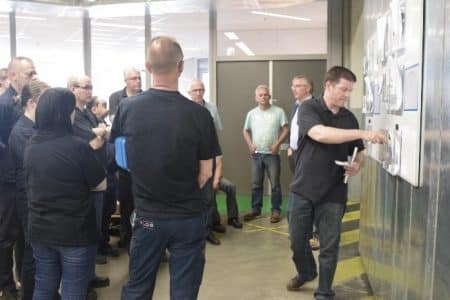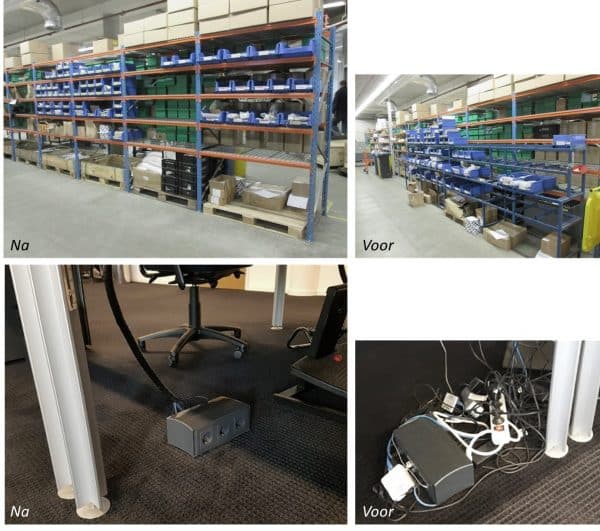Flos: Implementing 5S, “We wanted a lasting result”
Edwin Rauwerda is director of operations at FLOS and responsible for logistics/warehouses, assembly and KAM policies. He has been with FLOS, an organization focused on development, assembly, supply and inventory management of technical components including fasteners for industrial applications, since 2012.
These are produced at companies worldwide. FLOS offers its customers solutions in fasteners; ensuring that the customer gets the right product delivered, on time and for the relevant application.
FLOS operates in various markets, from supplying parts for agricultural equipment to automotive. All these markets are in flux, demanding ever higher quality and ever new techniques. For a number of years, FLOS has held “continuous improvement” in high regard, particularly in its internal processes.
Need
Recently, FLOS implemented “5S. The immediate reason for this was the recurring but unstructured tidbits when relations came to take a look behind the scenes at the FLOS organization.
Edwin Rauwerda says, “We were at a point, in 2015, where we wondered how we could better embed these cleanups into our system. Eventually we came to the conclusion, that we wanted to formulate a standard for the entire organization: how are you going to keep your workplace clean, set it up and keep it good. After some analysis and comparison, we concluded that 5S would be the best method at FLOS to achieve an organized workplace. We then started looking for a party that could help us with this. I myself took the Lean Six Sigma Green Belt course at Symbol and attended a number of workshops there. This gave me a good idea of the organization. So we invited Symbol. We stated what we wanted, and then Symbol was very emphatic in thinking with us and they worked out a plan of action.”
We wanted a lasting result
“We didn’t want to see 5S as a project with a beginning and end, but we wanted to actually get it into the DNA of the organization, carried by all employees. We actually started at the end of March 2016. With Symbol’s lean expert, the kick off for management took place. First, we properly identified the prerequisites for implementing 5S. What should the standard be? Do we want to organize everything very tightly or do we think it is enough if everything is stored in the drawer, drawer closed and done… Then we recorded the agreements that resulted from this. We still benefit from that today.
The output of the kick-off session was the starting point for induction workshops for all 75 Flos employees. These took place a month later, in April 2016. During these sessions, the outline of the methodology was explained.
To not only make the project successful, but also to secure it and get 5S into the company’s DNA, we set up what we call a 5S organization. A coordinator and team leader were appointed for each department so that eventually, with a group of 10 employees, we were able to spread and adjust the methodology throughout the organization.”
Involve everyone and get straight to work
“What we also did, and what I’d like to advise others to do, is really push people to implement and carry out the actions. We began with session S1 on the first S “Separation. The beautiful explanation and commentary did not expect everyone. With the theoretical knowledge gained, everyone returned to his/her workplace with the task of cleaning up his/her workplace according to the S1 principle. Sort out what you need and don’t necessarily need. The result was trash containers full of paper!
What struck me is that in projects of this magnitude, you always have to get commitment from everyone in the organization to make the project a success. You always have to deal with carters, karzitters and cart pushers and those who get in front of the wheels. Change also always leads to resistance. By involving, informing and challenging everyone as best we could, we were able to limit that resistance.
In addition to engaging people early on, you also need to keep them continuously informed so that the 5S theme stays alive. Areas of interest are also going to lose focus over time. Therefore, we had scheduled the sessions fairly close together, every 2 weeks. We also wanted to complete the project before summer vacation. But halfway through, we found out that this was a little too ambitious after all. One had to participate in the session every 2 weeks and implement the actions that resulted from it. That proved impossible. Therefore, we extended the schedule a bit and continued after the summer vacation. This was a conscious decision by FLOS and Symbol together. Rather take a little longer with quality output than too soon with poor quality.”
Make it visual
“Pretty early on in the start-up, we put up 5S white boards. Every department used the same system as a result. At these boards, weekly meetings were held, led by the 5S coordinator. A nice side effect was that you saw these new coordinators blossom in their roles. The signs also proved to work well for the employees, as they were able to make themselves heard and felt heard here.

Department meeting at the 5S board
In October, we had the final evaluation with Symbol. This was viewed very positively by both parties. Now we are about six months along as an organization and doing the frequently scheduled 5S audits without support from Symbol. In January, we had another “follow-up day” with Symbol’s lean expert. After 3 months, he comes back again to check with us to see how things are going. We also experience this as very positive. We are now more at the stage where people from the floor also start thinking about improvements; there are more questions coming from the shop floor and improvements are being spontaneously suggested.”
Tip for other organizations
“For optimal results, you have to be constantly working on this. It is easier in some departments than in others, where there is more resistance. But by setting up your organization properly with team leaders, for example, as we did, you can start building a culture of continuous improvement.
Tips for other organizations looking to implement continuous improvement and, as part of this, perhaps 5S:
- You need to know well what you want to achieve, so set your goal and boundary conditions;
- Tackle it organization-wide, 5S is a reflection of the entire organization;
- Get real about the sessions and follow-up;
- Keep everyone informed, evaluate, inform and share achieved results with each other.
Meanwhile, the 5S audit team comes throughout the organization. That is, someone from the sales department is now taking the 5S audit in the warehouse, for example. As a result, you get good cross-pollination. Each audit team has its own insights. Sharing throughout the organization, always going back to the preconditions and foundation, keeps everyone focused and on track.
We have photo material of all the sessions. If we then look back and compare the old situation with the new situation, we have made a great leap. Not only is it tidy (our initial goal of being able to lead relationships around without reservation and planning), we now work in a standardized way using the same resources and methods.
Following the 5S process, we also made a number of investments, which contribute to a good workplace, such as ergonomic work tables, 5S boards. And we were left with a lot of empty cupboards….”

Latest news/blogs
From ISO 9001 to IATF 16949
From ISO 9001 to IATF 16949As consultants with expertise in ISO 9001 quality management systems,...
Improving focus: Initial results from our survey
Improvement in focus: Initial results from our research Every year, organizations invest hundreds...
Deepfake deception: The double side of deepfakes
Deepfake Detection: The double side of deepfakes A recent shocking incident has impressively...


